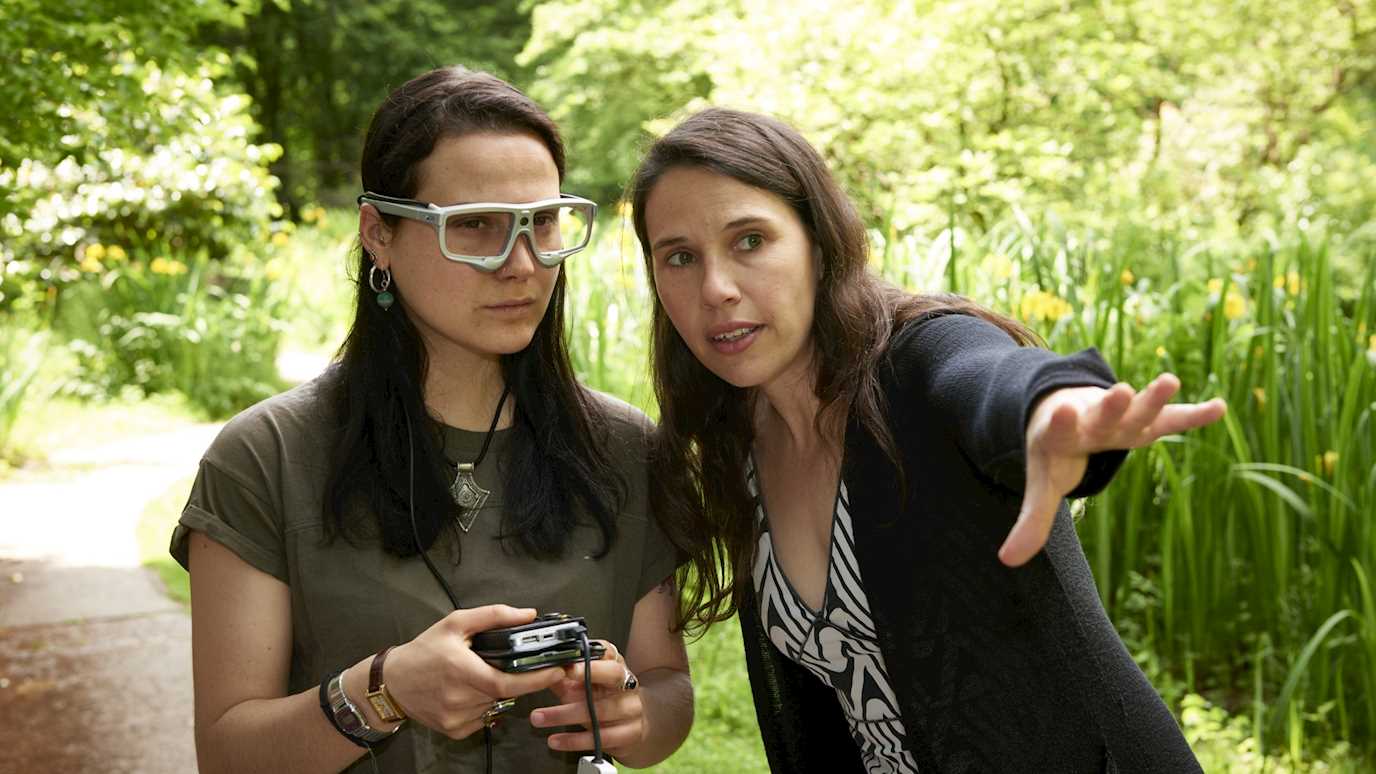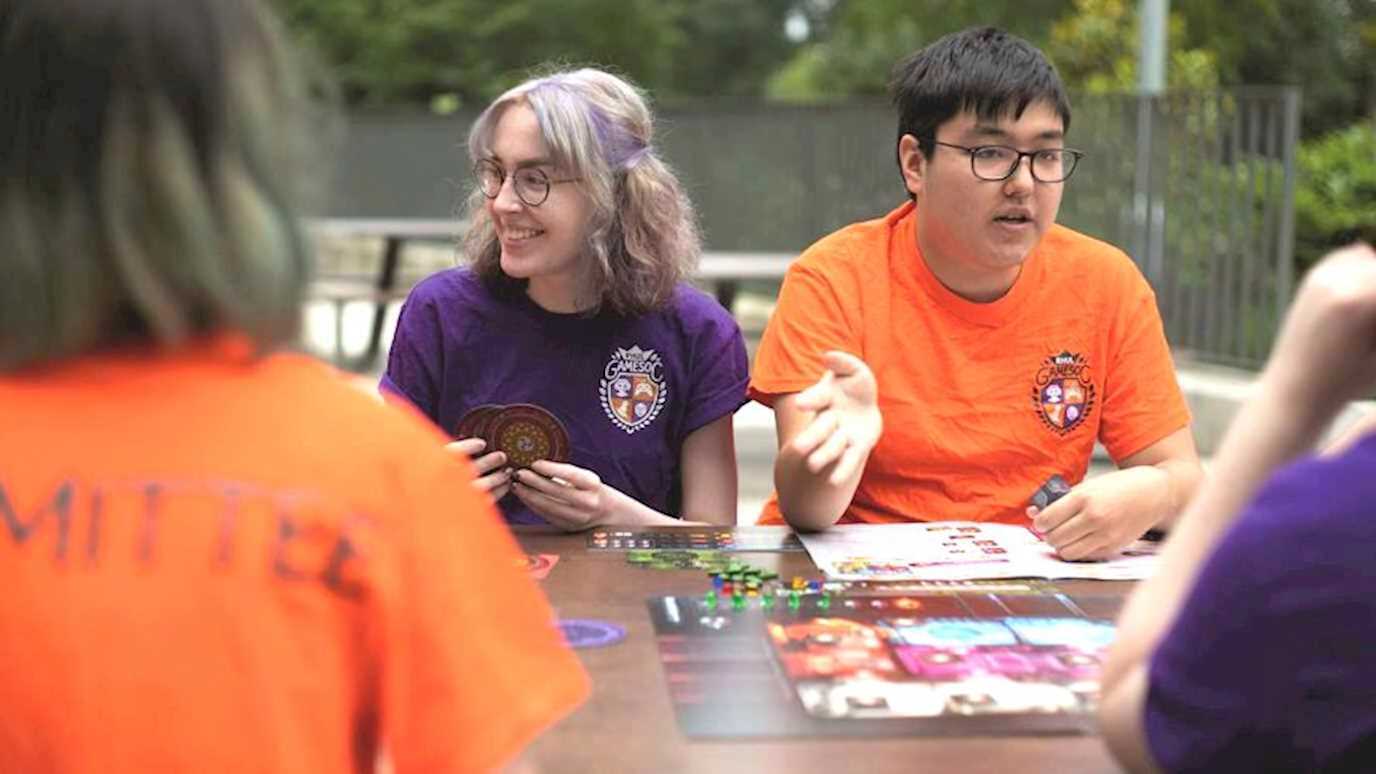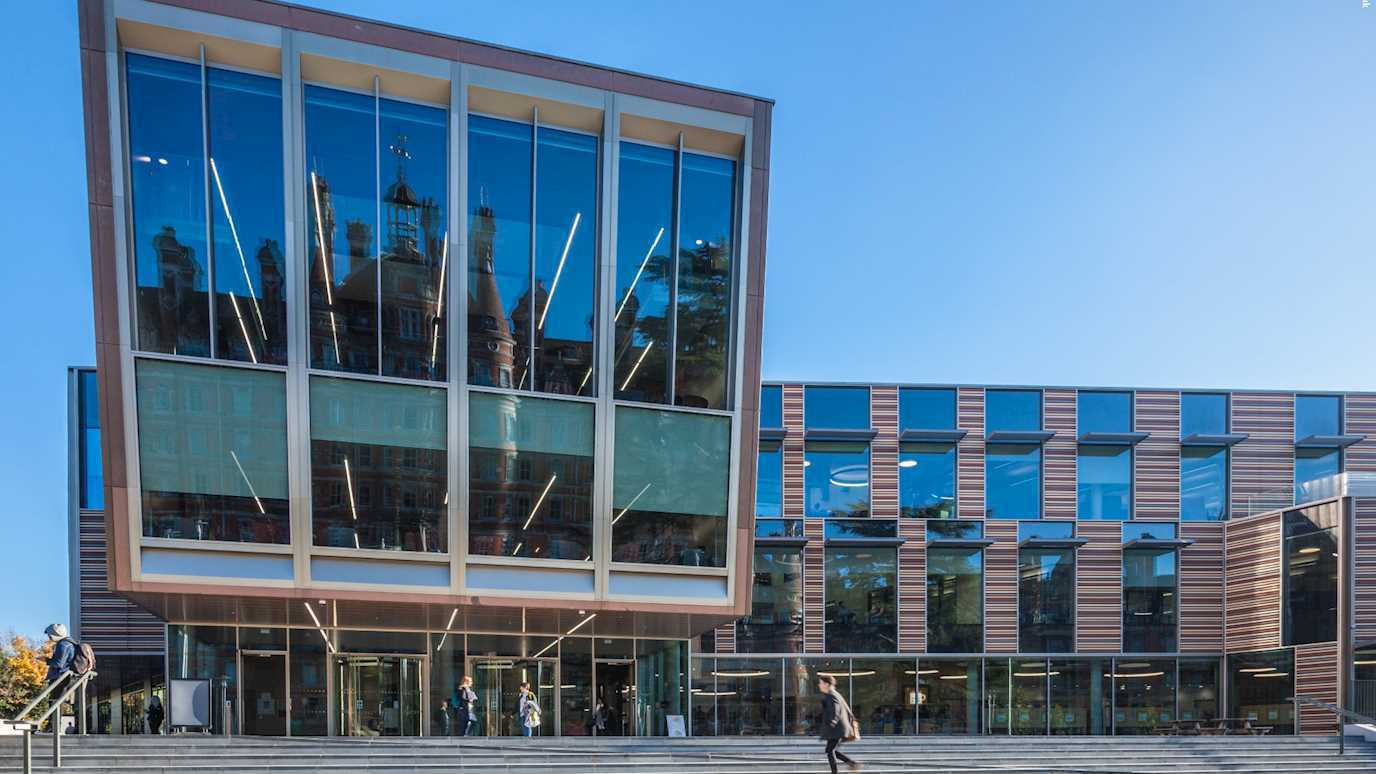The Research Project
This is a one-year Masters by research programme beginning in September every year.
Students with a good first degree in Biochemistry, Biology or related disciplines are offered the opportunity to develop their research skills (producing and critically evaluating novel data, use of advanced bioinformatics tools and presentation skills).
Our Research
Our research is formed of three research centres: Healthy Ageing and Molecular Medicine (HAMM), Sustainable Engineering and Food Security (SEFS), and Biodiversity and Ecosystem Services (BES).
Students accepted on the program will be trained and supervised by one of our Academic researchers on a single research project (usually selected by the student). Students will have hands on experience and will be trained in a wide range of advanced research methods.
This supervised project runs for approximately eight months and offers students the opportunity to:
- Work closely with a leading scientist in their chosen scientific subject
- Develop practical research skills in the lab or field at the highest level
- Become independent researchers,
- Learn to generate and critically analyse novel scientific data and
- Obtain experience working as part of a research team
Teaching and Learning Objectives
Although this is a research degree, a complementary and inventive taught component will provide training in transferable skills and will be delivered throughout the first two terms. As part of this, there is a requirement to complete coursework, prepare and present your research to a School audience by means of a poster, as well as a 20 minute oral presentation in the summer term.
All elements of the programme must be passed in order to be able to submit the final project report for assessment in the summer.
Students receive regular, scheduled, feedback on their performance in taught modules, their project plan, literature review/draft introduction (autumn term), draft materials and methods write up (spring term), preparatory oral presentation (spring term); assessed oral presentation (summer term); and draft project write up (summer term).
Award
As with most research degrees, the final write up will be assessed internally and externally at the end of the summer with the final award of a Masters by research degree in the following autumn term.
To find out more contact the Programme Director, Dr Paul Devlin.
Email: Paul.Devlin@rhul.ac.uk.
Tel: 01784 274698
Choosing and Applying for a Research Project
Before applying you will need to identify a supervisor and research project. A list of over 70 available projects can be found below. Alternatively, you can suggest your own project but, in such cases, we recommend that you contact your potential supervisor to discuss the project details before applying. As part of your application, you can list up to four supervisors/projects in order of preference so as to ensure availability.
When you have chosen the supervisors / projects that you are interested in, please apply here.
On the application form, list your chosen supervisor(s) and project title(s) in the “Course Details” tab. If you have chosen more than one supervisor / project title, please enter them in order of preference, separated by commas. For project titles, please just use the initial identifier rather than the full title (e.g. Devlin 1, Riesch 1).
If you have chosen supervisor(s) and project title(s) from our project listings below, then select, “Yes”, when asked, “Is this an advertised research project?” Please just give the address of this webpage when asked where they are advertised.
Also, if you have chosen supervisor(s) and title(s) from our listings below, then there is no need to upload a research proposal so please also select, “Yes”, when asked, “Have you agreed with your supervisor that you do not need to provide a research proposal?”
Applications should be made online before 29th August.
The prospectus can be viewed online.
Advice for international applicants on How to apply for a UK study visa.
See below for a list of projects and supervisors:
Dr Hrvoje Augustin
Augustin 1 - Biology of ageing: investigating the effect of novel compounds on longevity and functionality
One of the goals of ageing research is to identify compounds that can extend lifespan and/or improve physical and cognitive performance in old age. The research of the last 20 years revealed a high level of conservation of genetic pathways and biochemical processes that regulate lifespan in organisms as diverse as yeast, worms, flies and humans. The fruit fly Drosophila, in particular, emerged as a pre-eminent model system for studying changes that occur during both normal and pathological ageing (~75 per cent of the genes that cause disease in humans are also found in the fruit fly!). The advantages of Drosophila include their relatively low cost, ease of use and a range of powerful tools available for their genetic manipulation.
Our Department recently identified several compounds with possible pro-longevity effects. The aim of this project is to assess the effect of these compounds during healthy ageing and in various Drosophila models of human diseases. The initial lifespan studies will be followed by an array of molecular, biochemical, imaging and functional analyses.
Dr Hrvoje Augustin
Augustin 2 - Modelling neurodegenerative disorders in Drosophila
We use the fruit-fly Drosophila to study different aspects of human neurodegenerative diseases such as Motor neurone disease, Parkinson’s disease, Frontotemporal dementia and others. Our main goals are to a) understand the molecular underpinning of these disorders, and b) identify novel molecular targets and therapeutic approaches for future treatments. The most promising genetic or pharmacological interventions identified in flies can then be tested in suitable mouse disease models.
Research pages - Dr Hrvoje Augustin
Dr Laurence Bindschedler
Bindschedler 1 - How do pathogenic powdery mildew fungi cause disease with no cell death? Protein-protein interactions and gene regulation weapons for virulence and host susceptibility in cereals, cucurbits and other crops.
Pathogens secrete small proteins called effectors or virulence factors which are important for the successful invasion of the host. These effectors act by compromising the host immunity. Powdery mildews are economically important obligate fungal pathogens of many crops, including wheat, barley, pea strawberry or zucchini. Powdery mildew expresses and secretes many small proteins, most of them of unknown functions, except for the fact that they make the pathogen virulent. The production of these are regulated at the early stage of infection. To understand their function, we will be addressing one or some of the following questions:
When and where are they expressed? And what are the transcription factors regulating them?
Which of the plant host proteins do they target?
Are they species specific?
Are they required for a successful infection?
Molecular and proteomic approaches will be used to investigate the role of powdery mildew effector proteins of this plant pathogen during infection of barley by its powdery mildew.
Research pages - Dr Bindschedler
Dr Laurence Bindschedler
Bindschedler 2 - in planta RNAi to control diseases caused by obligate fungi in cereal crops
The aim of this project is to develop high output workflow for gene silencing of obligate plant pathogenic fungi with an ultimate goal of controlling plant diseases causing rust and powdery mildews.
RNA interference (RNAi) is a powerful technique to investigate gene function by down regulating the expression of a particular gene in vivo (i.e. gene silencing).
Large scale RNAi strategies were possible through the design of synthetic siRNAs in mammalian systems or artificial microRNAs in plants but depend on cloning and protoplasts production.
Newer methods to adapt RNAi to plant systems have emerged using either cell permeable peptides to use direct siRNA or oligodeoxynucleotides (ODN) molecules uptake in whole plants or leaves.
These silencing screening tools are instrumental for the designing of resistant genome edited plants.
Professor Laci Bogre
Bogre 1 - Balancing Assimilates for plant growth, cell proliferation and productivity
Plant growth and crop productivity is intimately linked to the efficiency of light capture and to the balanced storage and utilisation of assimilates. The evolutionary conserved TOR-S6K signalling pathway functions to adjust the rate of protein synthesis to demands (Deprost et al. (2007) EMBO Rep 8:864-870.).
Cell proliferation is repressed upon carbon starvation, and we have shown that S6K1 is playing a role in this process (Henriques et al. (2010) EMBO J 29:2979-93.). We have also shown that exposure of etiolated seedlings to light rapidly revert starvation and leads to activation of protein synthesis and cell proliferation in shoot apex.
Light has a direct input into cell proliferation through DET1 and COP1 which regulate the balance between transcriptional activator/repressor; E2FB/E2FC (Lopez et al (2008) Plant Cell 20:947-68.). Cell proliferation adjusted to available sucrose through regulating the expression, translation and protein stability of D-type cyclins and so RBR phosphorylation and leads to the release of E2FB to activate proliferation (Magyar et al (2012) EMBO J. 31:1480-93.).
On the other hand, E2FA forms a stable repressor complex with RBR to maintain the meristem, while E2FC appears to be involved in induction of genes involved in metabolism, light and circadian rhythm (deJager et al. (2009) PMB 71(4-5):345-65.). The central question of this project: how carbon balance is connected to the regulation of growth and cell proliferation.
Professor Laci Bogre
Bogre 2 - How plant growth is adopted to drought conditions
One major consequence of the global changes in climate is an uneven distribution of freshwater, leading to drought in large areas worldwide. This has already had a strong influence on agricultural productivity.
Our current understanding of plant adaptation to drought stress is limited to survival mechanisms, but little is known about how mild drought condition restrains plant productivity and yield. We have discovered a drought induced MAPK signalling pathway that restrains plant growth through multiple mechanisms; i) by regulation auxin transport, ii) regulating cell proliferation.
The overall aim of the proposed research is to identify cell cycle-regulatory targets of the drought-responsive MAPK signaling pathway, and link these to the growth adaptation of plants under drought stress conditions. To do this we will perform: (ii) computational predictions of MAPK substrates involved in cell cycle regulation, (iii) targeted approaches to test MAPK phosphorylation of key regulators in plant growth regulation, the RBR transcriptional repressor complex.
Dr Sofia Castelló y Tickell
Castelló y Tickell 1 - Exploring conservation in environmental comedy
While the biodiversity crisis may seem anything but funny, humour can provide unique opportunities to engage people with conservation issues. This project will focus on exploring the niche of environmental comedy through a systematic search and analysis of common themes relating to conservation science.
Dr Sofia Castelló y Tickell
Castelló y Tickell 2 - Measuring conservation impacts of human-made reefs
Human-made reefs include include a wide range of structures submerged by people in the ocean. In order to ensure the widest range of benefits for their use, it is crucial to undertake social and ecological monitoring and set appropriate targets. This project will focus on 1-2 case studies evaluating human-made reef projects, and derive lessons for future conservation metrics.
Reference:
Castelló y Tickell, S., Sáenz-Arroyo, A., & Milner-Gulland, E. J. (2019). Sunken Worlds: The Past and Future of Human-Made Reefs in Marine Conservation. BioScience, 69(9), 725–735. https://doi.org/10.1093/biosci/biz079
Dr Sofia Castelló y Tickell
Castelló y Tickell 3 - Creative conservation education with imaginary animals
As eco-anxiety rises and the biodiversity crisis looms, it is crucial to find ways to increase environmental literacy and communicate science without overwhelming young people. This project will consist of co-designing and evaluating a series of creative workshops with students of various ages, in which they will grapple with the ecology and conservation of an imaginary animal as a learning experience. The project will be co-supervised by Sofia Castello y Tickell and Becky Thomas.
Dr Philip Chen
Chen 1 - Pharmacology of glycine-site agonists at NMDA receptors
This project will characterise a number of novel agonists at NMDA receptors using molecular biology and recording glutamate evoked inward currents from oocytes injected with mutant NMDARs under two-electrode voltage clamp configuration. The project will involve molecular techniques such as subcloning, site-directed mutagenesis, PCR and in vitro cRNA synthesis, injection of cRNA into Xenopus oocytes and two-electrode voltage clamp electrophysiology.
Dr Philip Chen
Chen 2 - Examining the consequences of altered RNA editing on neuronal function
RNA editing is a process by which specific nucleotides are modified following gene transcription and disruptions in these processes have been linked to certain neurodegenerative conditions. We have developed a number of genetic tools to manipulate RNA editing and would like to explore their consequences on cell function. This project would involve mammalian tissue culture, RNA extraction, cell transfection and RT-PCR.
Professor Simon Cutting
Cutting 1 - Mucosal vaccines
Work consists of innovative bacterial delivery systems for mucosal vaccination (i.e. against malaria or TB). Due to the dynamics of our projects, they are ongoing and subject to change on a regular basis and cannot be specified in advance.
Dr Paul Devlin
Devlin 1 - Manipulating the plant phyllosphere microbiome for plant and environmental health
Healthy plants, like all higher organisms, host an extensive commensal microbial community or microbiome. Non-pathogenic microbes in many cases benefit the host. In plants, both the leaf microbiome, the phyllosphere, and the root microbiome, the rhizosphere, contain a wide range of bacterial and fungal species, including some that have been shown to play a range of roles in disease prevention. Changes in the microbiome can, therefore, have important effects on agricultural yield and microbial supplementation offers a real option for biological control of disease, reducing the need for fungicides. Understanding the rules of establishment of microbial supplements within the microbiome is currently a key knowledge gap, with many potential biological control agents failing to establish in the field under real agricultural conditions. This project will use a metabarcoding approach to analyse the impact of a range of biotic and abiotic stresses experienced by plants in the field on the phyllosphere microbiome and to try and establish the key elements that define a resilient microbial community. We will analyse the effects of both environmental and agricultural treatments. Effects on the microbiome of abiotic factors such as light, drought stress, plant immune responses and even internal plant circadian rhythms will also be tested. This project will also investigate the potential for probiotic treatment / microbiota transfer to help restore microbial homeostasis using synthetic communities (SynComs) cultured from microbes native to healthy untreated plants.
References:
Vincent et al. 2022, Front in Microbiol. 13:809940)
Gadhave et al. 2018, Microb Ecol 76:741-50
Dr Paul Devlin
Devlin 2 - Integration of light signals regulating the plant circadian clock
The greatest advantage of a circadian clock in plants is the accurate prediction of the timing of dawn and dusk. On the other hand, dawn and dusk also keep the clock in tune with the environment by resetting the clock forward or back slightly each day. This involves a fine balance and so plants have a range of photoreceptors that interact to convey accurate environmental information.
This project will look at integration of red and blue light signals as their relative importance changes through the course of a day. It will focus on the interaction of signals from the red light-regulated transcription factors, FHY3 and FAR1, and the blue light-regulated transcription factors HY5 and HYH.
References:
Rhodes et al. 2022, Front Plant Sci.13:862387
Liu et al. 2020, Plant Cell 32(5):1464-78
Li et al., 2011, Nature Cell Biology, 13: 616-622
Professor Alessandra Devoto
Devoto 1 - Developing environmentally friendly forms of plant protectants and phytopharmaceuticals
The project aims at elucidating several aspects of the control of plant defences and to identify environmentally friendly forms of plant protectants and phytopharmaceuticals, leading to enhanced crop yields and solutions for animals and human health.
Host processes and components required for the reproduction of plant microbes to uncouple stress-induced growth in plants are studied to open the possibility to engineer crops to gain ‘natural immunity’. Host processes linked with microbial growth to uncover cellular and metabolic changes associated with their demands will be elucidated This research will also further our understanding of biomass production and its regulation in response to stress to improve cell wall accessibility in biofuel feedstocks.
My projects span from experimental Sciences to BIG DATA dry projects and offer the opportunity to become familiar with approaches and techniques of wide applicability such as high-throughput functional genomics/ bioinformatics, epigenetics, as well as molecular biology and protein engineering and sustainable green technology.
Latest/ relevant References
Krasauskas et al 2023 JXBot 75:180; Vincent et al 2022, BMC Biology 20, 83; Bomer, Perez Salamo et al 2020. New Phytol 229:2120; Perez Salamo et al 2018 Annual Plant Reviews 2, p. 1-65; Noir et al, 2013, Plant Physiology 161: 1930-1951; Balbi and Devoto, 2008, New Phytologist, 177: 301-318
Professor Alessandra Devoto
Devoto 2 - Novel biotechnological routes to discovering phytopharmaceuticals
Pathways with potential to produce therapeutic drugs will be manipulated with the dual aim of developing a greater understanding of the metabolism involved, that is often related to plant defence, and to develop small molecules or precursors for new medicines. Success in manipulating the targeted metabolic pathways will be analyzed through a novel functional screening system. The analysis of diverse plant lines will improve the understanding of key pathways leading to the production of economically important compounds acting as toxins, antimalarial, or antineoplastic drugs in planta. This project will also contribute to identifying the link between plant growth and responses to stress and will lead to the discovery of regulators with the potential to engineer stress signalling pathways.
My projects span from experimental Sciences to BIG DATA dry projects and offer the opportunity to become familiar with approaches and techniques of wide applicability such as high-throughput functional genomics/ bioinformatics, epigenetics, as well as molecular biology and protein engineering and sustainable green technology.
Latest/ relevant References
Krasauskas et al 2023 JXBot 75:180; Vincent et al 2022, BMC Biology 20, 83; Bomer, Perez Salamo et al 2020. New Phytol 229:2120; Perez Salamo et al 2018 Annual Plant Reviews 2, p. 1-65; Noir et al, 2013, Plant Physiology 161: 1930-1951; Balbi and Devoto, 2008, New Phytologist, 177: 301-318
Professor Alessandra Devoto
Devoto 3 - Analysis of chromatin remodelling increase fitness potential during stress responses
Understanding the mechanism by which chromatin remodelling and/or hormone signalling components work in regulating cell growth in response to the stress, will contribute to increase fitness potential (and biomass or high value chemicals, accumulation) of plants during stress, a critical issue for a sustainable agriculture development. Using high-throughput functional genomics, the role of newly identified molecular components will be established. This project will contribute to identifying the link between plant growth and responses to stress and will lead to the discovery of regulators with the potential to engineer stress signalling pathways. The knowledge accumulated here will be applied to crops.
My projects span from experimental Sciences to BIG DATA dry projects and offer the opportunity to become familiar with approaches and techniques of wide applicability such as high-throughput functional genomics/ bioinformatics, epigenetics, as well as molecular biology and protein engineering and sustainable green technology.
Latest/ relevant References
Krasauskas et al 2023 JXBot 75:180; Vincent et al 2022, BMC Biology 20, 83; Bomer, Perez Salamo et al 2020. New Phytol 229:2120; Perez Salamo et al 2018 Annual Plant Reviews 2, p. 1-65; Noir et al, 2013, Plant Physiology 161: 1930-1951; Balbi and Devoto, 2008, New Phytologist, 177: 301-318
Professor Paul Fraser
Fraser 1 - Commercial applications of biochemistry: optimising enzyme production for key industrial assays
Carotenoids are natural pigments responsible for many of the bright orange and yellow colours found in nature. As such, they have important industrial uses in the food, food and cosmetics sectors as natural colourants. In plants, they fulfil essential roles in photosynthesis, antioxidant protection and regulation of plant growth. This has made carotenoid biosynthesis a key herbicide target. The group has expressed and produced key carotenoid biosynthesis enzymes, including phytoene and zeta-carotene desaturase, in E. coli.
The aim of the project is to optimise production, purify and then characterise the carotene desaturase enzymes. This will be done by (i) microbial cultivation, induction, expression, and assessment of proteins on SDS-PAGE, (ii) purification using chromatographic techniques and (iii) determination of activity by in vitro and in vivo complementation.
The project will provide the individual with a fundamental biochemical skillset that has wide-reaching applicability across multiple industrial sectors including agrichemical and pharmaceutical companies which require the monitoring of enzyme inhibition for agrochemicals and novel medicines. All necessary resources are in place and the laboratory has a long-standing expertise in this area. A £3000 scholarship towards fees is available for the right candidate.
Professor Paul Fraser
Fraser 2 - Engineering fungal cellular factories: unlocking natural potential for bioproduction of high-value compounds
Fungi are capable of sustainable bioproduction of a wide range of commercially relevant compounds without the need for oil-based chemicals. Improved biosynthesis of these important chemicals can be achieved using mutagenesis.
Carotenoids are one such class of valuable compounds whose uses include aquaculture, cosmetics and preventative treatments for a wide range of health conditions. Carotenoid biosynthesis is ideally suited to mutagenesis because these compounds are (i) brightly coloured to enable rapid visual screening, (ii) terminal and intermediate products are of high value and (iii) the genetics and biochemistry of the pathway is well characterised.
In this project the mutagens Nitro-N-nitrosoguanidine (NNG) and Ethyl methane Sulfonate (EMS) will be used generate a suite of mutants that will be characterised biochemically to identify the carotenoids and their precursors present. Mutagenesis will be applied to the non-conventional industrial yeasts Xanthophyllomyces dendrorhous and Sporobolomyces, which produce astaxanthin and torularhodin respectively, as well as bacterial species, Paracoccus carotinifaciens, which produces valuable ketocarotenoids.
This project will provide the individual with fundamental biochemistry and molecular biology skillsets in an applied, commercially important area. Biotechnology industries are highly active in this field. All the resources are in place and the laboratory has a long-standing expertise in this area. A £3000 scholarship towards fees is available for the right candidate.
Professor Paul Fraser
Fraser 3 - Biofactories of the future: sustainable, plant-based solutions to replace unsustainable practices
Plants are an ideal host for the biorenewable production of important compounds as an alternative to traditional, oil-based chemical synthesis or other non-sustainable sources. Plants are low input, low energy, sustainable and can make use of existing infrastructure.
One class of compounds ideally suited to production in plants are isoprenoids, many of which have bioactive properties and are of high value. Examples included: squalene, a cosmetic ingredient and important vaccine adjuvant, astaxanthin, a potent antioxidant and food colorant, as well as beta-carotene which is provitamin A. Squalene has historically been produced from the destructive harvesting of shark livers, harming deep sea shark populations and their specialised ecosystems, while astaxanthin is usually chemically synthesised from petrochemical feedstocks.
The laboratory has made bio-based systems producing these compounds. The proposed experimental project will characterise these novel lines biochemically and at the molecular level to understand how these molecules are formed. In addition, new down-stream processing approaches, with improved sustainability credentials, will be deployed.
The project will provide the individual with a fundamental biochemistry and molecular biology skillset in an applied subject. Biotechnological industries are highly active in this field with astaxanthin and squalene in high demand. All resources are in place and the laboratory has a long-standing expertise in the area. A £3000 scholarship towards fees is available for the right candidate.
Professor Paul Fraser
Fraser 4 - Exploiting enzymes for sustainable production of medical and industrial compounds
Carotenoids and sterols are hugely important classes of commercially relevant compounds with applications in health and medical science, aquaculture and cosmetic industries. The key enzymes controlling the biosynthesis of these compounds in plants are phytoene synthase and squalene synthase respectively, the latter producing the leading vaccine adjuvant. The group has expressed and produced these enzymes in E. coli.
The aim of this project is to optimise production of, purify and characterise these crucial enzymes. This will be done by (i) microbial cultivation, induction, expression, and assessment of proteins by SDS-PAGE, (ii) purification using chromatographic techniques and (iii) determination of activity by in vitro and in vivo complementation.
The project will provide the individual with a fundamental biochemical skillset that has wide-reaching applicability across multiple industrial sectors including pharmaceutical companies which require the monitoring of enzyme activities and cell free enzyme solutions. All necessary resources are in place and the laboratory has a long-standing expertise in this area. A £3000 scholarship towards fees is available for the right candidate.
Professor Paul Fraser
Fraser 5 - Leveraging next-generation technologies to explore critical processes in tomato ripening
During tomato ripening, chloroplasts transition into the pigment storage plastid type, chromoplasts. This is accompanied with a broad spectrum of ripening associated changes including the rapid increase in carotenoid pigment levels. Through the modulation of carotenoid biosynthesis the group has been able to alter these structures, initiating artificial chromoplast formation from chloroplasts.
In the present project the researcher will investigate this phenomenon in more detail to understand the underlying biochemical and molecular mechanisms associated with this process. To achieve this goal chloroplasts and those transitioning to chromoplasts will be isolated. Next-generation technologies will be employed to determine metabolite changes as well as proteomics to track changes in key proteins involved in chromoplast formation.
The project will provide the individual with a fundamental biochemical skillset that has wide-reaching applicability across multiple industrial sectors such as the agribiotech industry investigating nutritional quality in fruits. All resources are in place and the laboratory has a long-standing expertise in the area. A £3000 scholarship towards fees is available for the right candidate.
Professor Paul Fraser
Fraser 6 - Applying biochemistry: how is fibrillin involved in plant pigment production?
Pigment accumulation in plants frequently occurs in specialised organelles called chromoplasts. Within chromoplasts are structures called plastoglobuli which were believed to be simple lipid storage components. However more recently, the identification of metabolic enzymes within plastoglobuli has led to several postulated roles in metabolism. Plastoglobuli have also been shown to contain a multigene family of structural proteins termed Fibrillins. An abundant protein from the Fibrillin family, has been expressed in E. coli.
The aim of this project is to now optimise production, purify and characterise this Fibrillin to aid in the elucidation of its role in pigment accumulating chromoplasts. This will be done by (i) microbial cultivation, induction, expression, and assessment of proteins by SDS-PAGE, (ii) purification, performed using chromatographic techniques, and (iii) carotenoid binding, investigated by in vitro and in vivo complementation.
The project will provide the individual with a fundamental biochemical skillset that has wide-reaching applicability across multiple industrial sectors where protein purification and binding assays are vital to elucidate metabolite and drug interactions, for example. All necessary resources are in place and the laboratory has a long-standing expertise in this area. A £3000 scholarship towards fees is available for the right candidate.
Dr Cristina Garcia Perez
Garcia Perez 1 - Engineering seed synthetic microbiome communities to enhance seed germination of native trees to the UK
Plants rely on a diverse assemblage of micro-organisms (microbiome) to fulfil their life cycle, but we still ignore the composition, diversity, and function of the seed microbiome. This is a critical knowledge gap because seeds are the most vulnerable stage in the plant demographic cycle. As a result, low seed germinability is the main factor hampering rewilding, i.e., forest expansion over formerly managed areas depleted of vegetation. Rewilding of plant communities is highlighted by the IPBES as the main nature-based solution to halt biodiversity decline and mitigate the impacts of climate change. This project aims to test whether seed germinability of trees relies on the species composition of the seed microbiome, specifically on seed bacteria. community. Specifically, we will test if animal-dispersed seeds secure bacterial communities that enhance seed germination from the guts of their mutualistic frugivores, in turn providing most suitable conditions to germinate and establish successfully. The main goals main goals are: (i) Describing the species composition and function of the seed microbial communities -based on 16S rDNA- for tree species (N~35) native to UK; (ii) Elucidating whether seed microbiomes impact seed germinability and, if so, identifying the combination of micro-organisms that attain higher germinability and recruitment under different simulated environmental conditions, including drought; (iii) Investigating the role of frugivores in shaping the composition and function of the seed microbiome; (iv) Engineering synthetic seed microbial communities that enhance seed germination and long-term establishment of native trees. Overall, this study will provide scientific evidence to initiate forest improved regeneration trials based seeds coated with synthetic seed microbial communities to trigger forest recovery (knowledge transfer).This project will address the following skill gaps: (i) Designing seed germination trials across multiple tree species native to the UK; (ii) Optimize and apply DNA extraction protocols (bacterial 16S rDNA); (iii) Apply statistical tools to characterize and compare seed microbial communities; and (iv) Learn how to engineer seed microbial communities; v) Plotting informative figures summarizing most relevant results (to acquire some basic knowledge on infographics); and vi) Draft a scientific manuscript aimed to publish main relevant results of this project.
Dr Cristina Garcia Perez
Garcia Perez 2 - Are mountain passes higher in the tropics? A plant ecology approach
Daniel Janzen hypothesized that the breadth of the thermal niche of organisms determines their distribution ranges as well as the turnover of species across altitudinal gradients (Janzen 1967). This predicts that narrow climatic variation of the tropics determines narrow thermal niches of tropical species, which might hamper their expansion across altitudinal or latitudinal gradients. This hypothesis has been confirmed for insects, birds, mammals, and lizards, but we still ignore whether it also applies to plants. This knowledge gaps hampers our understanding of plant responses to increasing warming conditions and limit our ability to forecast their ability to persist in a changing world. This project aims to test the hypothesis that tropical species show narrower thermal niches compared to non-tropical species. By doing so we will investigate the role of thermal niche in driving plant responses to increasing warming. We will use a combination of data bases to depict the breath of the climatic niche and to gather ancillary data on key functional traits such as dispersal and pollination mode, lifespan, phenology, and phenotypic traits. This project will address the following skill gaps: (i) Designing and applying a pilot study to identify and avoid common statistical pitfalls (pseudorreplication, zero inflated data, low statistical power, phylogenetic bias); (ii) Based on the feedback from the pilot study, defining a data frame with the suitable number and type of variables and records to be analysed with R; (iii) Gathering data from a combination of data bases (books, guides, climate data bases, and online repositories); and (iv) Applying multivariate tools to depict and compare the breath of the climate niche of plants and phylogenetic regressions to identify main functional traits driving plant responses; v) Plotting informative figures summarizing most relevant results (to acquire some basic knowledge on infographics); and vi) Draft a scientific manuscript aimed to publish main relevant results of this project.
Dr Cristina Garcia Perez
Garcia Perez 3 - Engineering seed synthetic microbiome communities to enhance seed germination of native trees to the UK
Plants rely on a diverse assemblage of micro-organisms (microbiome) to fulfil their life cycle, but we still ignore the composition, diversity, and function of the seed microbiome. This is a critical knowledge gap because seeds are the most vulnerable stage in the plant demographic cycle. As a result, low seed germinability is the main factor hampering rewilding, i.e., forest expansion over formerly managed areas depleted of vegetation. Rewilding of plant communities is highlighted by the IPBES as the main nature-based solution to halt biodiversity decline and mitigate the impacts of climate change. This project aims to test whether seed germinability of trees relies on the species composition of the seed microbiome, specifically on seed bacteria. community. Specifically, we will test if animal-dispersed seeds secure bacterial communities that enhance seed germination from the guts of their mutualistic frugivores, in turn providing most suitable conditions to germinate and establish successfully. The main goals main goals are: (i) Describing the species composition and function of the seed microbial communities -based on 16S rDNA- for tree species (N~35) native to UK; (ii) Elucidating whether seed microbiomes impact seed germinability and, if so, identifying the combination of micro-organisms that attain higher germinability and recruitment under different simulated environmental conditions, including drought; (iii) Investigating the role of frugivores in shaping the composition and function of the seed microbiome; (iv) Engineering synthetic seed microbial communities that enhance seed germination and long-term establishment of native trees. Overall, this study will provide scientific evidence to initiate forest improved regeneration trials based seeds coated with synthetic seed microbial communities to trigger forest recovery (knowledge transfer). This project will address the following skill gaps: (i) Designing seed germination trials across multiple tree species native to the UK; (ii) Optimize and apply DNA extraction protocols (bacterial 16S rDNA); (iii) Apply statistical tools to characterize and compare seed microbial communities; and (iv) Learn how to engineer seed microbial communities; v) Plotting informative figures summarizing most relevant results (to acquire some basic knowledge on infographics); and vi) Draft a scientific manuscript aimed to publish main relevant results of this project.
Dr Deborah Harvey
Harvey 1 - How does connection to nature affect science attainment in school pupils
This Masters is part of the Royal Holloway Schools’ Biodiversity Project and will investigate how working with children in their school grounds affects their connection to nature and science attainment, particuarly in biology but also more generally. You will visit children weekly and work with them on projects to monitor species or create habitats in their grounds. The ability to work with children and to handle a wide range of species is essential. You will learn social science surveying and analysis techniques as well as identification, surveying and data collection techniques suited to citizen science projects centred around children.
Dr Deborah Harvey
Harvey 2 - The effect of light and sound pollution on urban wildlife
This Masters will investigate how light and sound pollution affect urban species, measuring changes in their behaviour using various survey methods. Working across a range of urban landscapes, you will need to enjoy fieldwork and have good identification skills and a keen interest in urban ecology, as well as behavioural biology. This project is suitable for a wide range of diurnal and nocturnal species.
Professor Vincent Jansen
Jansen 1 - Models for social interaction in microbes
Microbes interact in various ways, for instance they can release antibiotics to stave off competitors, or they can release substances which help other microbes take up iron from the environment. In this way basic ecological interactions, such as competition or mutualisms can be realised in very simple organisms. This project aims to develop simple models for the interaction of microbes. Once such a model is formulated and analysed, it can then be used to study the evolution of microbes in a theoretical fashion. This project will concentrate on the production of siderophores, which allow microbes to interact through the production of a public good. This is a theoretical project that will require some experience and interest in mathematical modelling.
Professor Vincent Jansen
Jansen 2 - Models for social interaction between fungi and plants
Fungi interact with plants in various ways, for instance as pathogen, but they can also engage in a mutualistic interaction through the formation of mycorrhizas. They can release antibiotics to stave off competitors, or they can release substances which help other microbes take up iron from the environment. In this way basic ecological interactions, such as antagonisms or mutualisms can be realised. This project aims to develop simple models for the plant-fungal interaction of microbe. Once such a model is formulated and analysed, it can then be used to study the evolution of microbes in a theoretical fashion. This is a theoretical project that will require some experience and interest in mathematical modelling
Professor Julia Koricheva
Koricheva 1 - Why not all deciduous trees shed their leaves in winter? The curious case of marcescence
Several deciduous tree species retain all or some senesced leaves on branches through much of winter, a phenomenon called leaf marcescence. This project will explore the frequency and phenology of marcescence in several tree species as well as its potential functional significance. It has been proposed that benefits of retaining dead leaves over winter might include protection of buds from frost, deterrence of herbivores, provision of overwintering habitat for predators such as spiders, or improvement of nutrient resorption. The project will test some of the above hypotheses.
References:
Heberling, J. M., and Muzika R.M. (2023). Not all temperate deciduous trees are leafless in winter: the curious case of marcescence. Ecosphere 14: e4410.
Pearse, I.S. et al. (2020) Generalising indirect defence and resistance of plants. Ecology Letters 23: 1137-1152.
Professor Julia Koricheva
Koricheva 2 - Do managed honeybees have negative effects on wild bees?
Concern has arisen that managed honeybees may have unintended negative impacts on native wild bees, which are important pollinators in both agricultural and natural ecosystems. These negative effects may arise because of competition for floral and nesting resources, changes in plant communities, including the spread of exotic plants and decline of native plants, and transmission of pathogens. This project will review the evidence of effects of managed honeybees on wild bees through a meta-analysis, which is a set of statistical methods designed to combine the results from independent studies on the same topic. Training in meta-analysis will be provided.
References:
Iwasaki, J. M. and K. Hogendoorn (2022). Mounting evidence that managed and introduced bees have negative impacts on wild bees: an updated review. Current Research in Insect Science 2: 100043.
Mallinger RE, Gaines-Day HR, Gratton C (2017) Do managed bees have negative effects on wild bees? A systematic review of the literature. PLoS ONE 12: e0189268
Wojcik V.A. et al. (2018). Resource competition between honey bees and wild bees: is there clear evidence and can we guide management and conservation? Environmental Entomology 47: 822–833.
Professor Gerhard Leubner
Leubner 1 - Molecular and hormonal mechanisms underpinning seed technologies applied to crop, flower and vegetable seeds by industry
The aim of this project is to determine the mechanisms which are underlying seed enhancement technologies to achieve rapid and uniform germination and seedling establishment. These technologies include seed priming, sorting, pelleting and the inclusion of various additives. Examples for the effects include the release of seed dormancy of vegetable and flower seeds, the control of aging processes during sugarbeet and onion seed storage and the benefits of priming to improve abiotic stress responses and vigour during germination and pre-emergence seedling growth (see projects on our PURE website below). The underlying mechanisms include regulation by altered hormonal contents and signalling and epigenetic changes leading to distinct transcriptome expression patterns. Very little is known about these mechanisms and therefore the optimisation of the seed enhancement technologies and their application to specific crop species is hampered. In the project we will investigate crop seed enhancement technologies with modern molecular, biochemical, microscopical and biophysical methods to understand how embryo growth, dormancy release and germination speed, uniformity and vigour are improved. This project is at the interface of fundamental and applied seed biology and engineering.
For enquiries about Projects in the Leubner laboratory, please contact Prof Gerhard Leubner.
Research pages - Professor Leubner
Project pages 'The Seed Biology Place'
Professor Gerhard Leubner
Leubner 2 - Molecular mechanisms of gene expression during weed seed dormancy, germination and persistence in the soil seed bank
The sustainable intensification of food production necessary to feed the world’s growing population will only be achievable if crop harvest losses due to heat stress and competition with weeds are minimised. About ten per cent of crop production is currently lost to weeds and this loss would be far greater without the use of herbicides. However, the continued effectiveness of herbicide technology is threatened by the rapid advance of weed biotypes that are resistant to herbicides. The problem of effective weed control is most severe in annual field crop systems and with annual weeds which emerge at the same time as the crop seedlings. These problem weeds owe their success, at least in part, to the formation of large and persistent soil seed banks. Thus there is considerable potential for novel weed control solutions through engaging a deeper understanding of the molecular mechanisms of weed seed germination and survival. In the project we will focus on hormone-related mechanisms which mediate the environmental responses of weed seeds. Seed hormones will be quantified and the expression of corresponding genes analysed in the seeds of a variety of noxious weeds and in response to temperature as environmental factor. This project is in collaboration with Syngenta and at the interface of fundamental and applied seed science.
For enquiries about Projects in the Leubner laboratory, please contact Prof Gerhard Leubner.
Research pages - Professor Leubner
Project pages 'The Seed Biology Place'
Professor Gerhard Leubner
Leubner 3 - Biopriming as a seed technology and its impacts on germination and seedling vigour
This project aims to investigate the interactions between bacterial endophytes and the seeds of high yielding crop species. Biopriming is a priming technology whereby seeds are hydrated and inoculated with a beneficial organism. Seed priming to modify hydration has been found to have several physiological benefits in the vegetable seed market such as increasing the uniformity and speed of germination. Biopriming however, builds upon this principal with the addition of a microbial inoculant. These are typically microorganisms that may confer benefits to the growing plant such as greater access to macro and micro-nutrients or host plant defence. This project will work with a specific nitrogen fixing bacterial endosymbiont and consider the impacts that seed inoculation with this bacteria on germination, seedling establishment and seed hormones on a range of plant species that exist in different agroecological niches. This project will utilise modern microbiological, microscopical, biochemical and hormone quantification techniques and is likely to work closely with industry partners, with the possibility of a short industry placement.
For enquiries about Projects in the Leubner laboratory, please contact Prof Gerhard Leubner.
Research pages - Professor Leubner
Project pages 'The Seed Biology Place'
Professor Enrique Lopez
Lopez 1 - Genes involved in chloroplast biogenesis
Leaves are light-capturing organs, “biological solar panels”, whose “solar cells” are the subcellular organelles, chloroplasts. Chloroplast build-up is essential for the photosynthetic production that drives our entire biosphere, and that ultimately produces our food. Chloroplasts are built primarily while meristematic cells differentiate into leaf mesophyll cells. Through mutant screens in the model plant Arabidopsis thaliana, we have identified several genes whose function is essential for chloroplast biogenesis, or whose dysfunction rescues prior defects in chloroplast development (positive elements or negative regulators of chloroplast biogenesis, respectively). In this project (several are parallel) you will focus on one of these genes, confirm its identity and examine potential mechanisms of action, through examination of molecular and cellular phenotypes of the mutants and through generation of Arabidopsis plants with elevated levels of the selected gene, or examining plants in which we have already modified the action of one of those genes in rice, one of the world’s most important crops.
Professor James McEvoy
McEvoy 1 - Sociality of antibiotic resistance in E. coli
Antimicrobial resistance (AMR) is a growing threat to public health, and antibiotic-resistant Escherichia coli is responsible for more AMR-associated deaths than any other pathogen. E. coli cells which express a b-lactamase enzyme can protect susceptible cells from b-lactam antibiotics by removing them from the environment. In this microbiological project you will use a highly-automated bioreactor to investigate the social aspects of antibiotic resistance in E. coli co-cultures, extending our work by using clinically relevant b-lactamase inhibitors and morbidostat growth modes. Our long-term objective is to inform therapeutic practice and improve infection outcomes.
Reference: Amanatidou, E.; Matthews, A. C.; Kuhlicke, U.; Neu, T. R.; McEvoy, J. P.; Raymond, B., Biofilms facilitate cheating and social exploitation of β-lactam resistance in Escherichia coli. npj biofilms and microbiomes 2019, 5, 36.
Dr Sarah Papworth
Papworth 1 - Using camera traps, automated behavioural experiments and machine learning to understand how garden birds respond to humans
Human presence causes changes in animal behaviour which can impact species survival – for example scaring birds away from nests will reduce the food available to their offspring, threatening their survival. As more humans use spaces with wild animals, understanding behavioural responses to human presence can help predict which species are likely to be most impacted, and how effects can be mitigated. Well-supported theories can help that understanding and allow generalised predictions to be made across species and sites. However, competing theories of animal responses to humans are tested for specific species and locations and rarely contrasted, due to the intensive fieldwork required. This project is part of a larger study defining a new, more generalisable behavioural hypothesis which can be used across a variety of human-wildlife interactions and animal species using novel field and analysis frameworks.
This MSc project will use camera traps and playbacks of sounds to wood pigeons and other garden birds to understand how they respond to human noise. The camera-trap experiments will be conducted in garden sites on an urban-to-rural gradient. Sites will be identified in London, on campus, and in the greater Surrey area, including areas close to farmland and hunting clubs. Camera traps are a great way to collect data, but they can collect so much it makes data processing very time consuming, so we will use machine learning to identify species and classify their behaviour. The project will require fieldwork in the UK, and the ideal candidate would have a driving licence and access to a car. The first data collection is planned for early October. You will gain experience in experimental design, camera trapping field techniques and the use of machine learning to process animal behaviour data.
Useful reading:
Liu et al. (2023). Ungulates’ Behavioral Responses to Humans as an Apex Predator in a Hunting-Prohibited Area of China. Animals, 13(5), 845. https://doi.org/10.3390/ani13050845
Palmer et al. (2022). BoomBox: An Automated Behavioural Response (ABR) camera trap module for wildlife playback experiments. Methods in Ecology and Evolution, 13, 611–618. https://doi.org/10.1111/2041-210X.13789
Suraci et al. (2017). A new Automated Behavioural Response system to integrate playback experiments into camera trap studies. Methods in Ecology and Evolution 8:957-964 https://doi.org/10.1111/2041-210X.12711
Widén et al. (2022). Playbacks of predator vocalizations reduce crop damage by ungulates, Agriculture. Ecosystems & Environment 328: 107853. https://doi.org/10.1016/j.agee.2022.107853
Professor Linda Popplewell
Popplewell 1 - Highly applicable genome editing for Duchenne muscular dystrophy (DMD)
Genome editing has the potential to address the acknowledged issues associated with the approved therapies of exon skipping (applicability and transience) and AAV gene addition therapy (functionality and uncontrolled expression). However, safety issues related to low efficacy, undesired consequences of targeted DNA cleavage repair and high risk of off-target editing, make approvals for clinical testing for any CRISPR-Cas9 genome edit difficult to procure. To address this, we are seeking to enhance near-universal genome editing strategies for DMD through exploitation of the recently published PASTE (Programmable Addition by Site-Specific Targeting Elements) technology to: (i) remove the need for double strand break for targeted integration; (ii) improve the efficiency of dystrophin transgene knock-in, and (iii) ensure applicability to non-dividing skeletal and cardiac muscle. This masters project would focus on optimisation of the delivery vector and its design for the targeted knock-in in cultured DMD patient muscle cells and the assessment of its efficiency at the DNA, RNA and protein level using qPCR, RT-qPCR and Western blotting.
Professor Linda Popplewell
Popplewell 2 - Gene editing for Becker muscular dystrophy (BMD)
Severity of BMD is related to the specific disease-causing in-frame internal deletion rather than the dystrophin expression level. Deletions resulting in a truncated dystrophin with a structure distinct from the full-length wild-type protein have expedited clinical decline with earlier loss of ambulation and onset of dilated cardiac myopathy, relative to mutations expressing dystrophin proteins with similar structures to wild-type. We are developing single guide RNAs (sgRNAs) targeting human and mouse introns 44 and 51 to convert severe BMD mutations Δ45-47 and Δ45-49 into Δ45-51, a BMD deletion with much milder clinical severity. This masters project would contribute to the optimisation and screening of multiplexed SaCas9 sgRNAs in appropriate control and BMD patient cell lines, using qPCR, RT-qPCR and Western blotting to assess efficacy of deletion creation at DNA, RNA and protein levels. Overall this project has the potential with development to improve disease phenotype and delay clinical progression with applicability to a high proportion of BMD patients.
Professor Linda Popplewell
Popplewell 3 - Exon skipping for Becker muscular dystrophy (BMD)
Dystrophin protein structure around a BMD in-frame deletion determines disease severity and progression rate. The prevalent mutation of del45-49 encodes dystrophin with a structure unrelated to native protein and a more severe disease phenotype with earlier onset and accelerated progression results. In contrast, due to preservation of protein structure, the prevalent del45-51 mutation has a much milder phenotype. This masters project would focus on the development of AOs for targeted exon 50 and 51 skipping for del45-49 to convert the expressed dystrophin from one associated with severe BMD phenotype to one associated with milder disease. In silico designed AOs will be packaged into AAV plasmids into U7-SnRNA cassettes and screened in wildtype cells for individual exon skipping efficacy using RT-PCR analysis of harvested RNA. Optimal SnRNAs for the skipping will be multiplexed into a single plasmid and assessed for dual exon skipping. If time allows, exon skipping AAV vectors would be produced for the transduction of del45-49 BMD muscle cells. The effect on the dystrophin protein expressed would be examined using Western blot analysis to assess loss of hinge 3 which encoded by exon 50 and 51.
Professor Linda Popplewell
Popplewell 4 - Alteration of APP splicing for Alzheimer’s disease (AD)
We have previously optimised antisense oligonucleotides that alter the splicing of two exons within the pre-mRNA that encodes amyloid precursor protein to shift isoform expression from one that contributes to the pathogenicity of AD to one that has the potential to protect against disease progression. This masters project would develop these further through examination of efficacy of U7-SnRNA mediated expression of longer antisense sequences. 45mer sequences will be designed using in silico tools and cloned into U7-SnRNA expression AAV plasmids and alteration of splicing examined using RT-PCR following treatment of human neuronal cells and harvesting of RNA. Optimal designs to each target exon will be combined into a single plasmid and Western blot analysis used to confirm shift in isoform expression. RT-qPCR will be used to examine expression of AICD and NEP, proteins that protect against amyloid plaque formation in AD.
Professor Linda Popplewell
Popplewell 5 - Highly applicable gene therapy for neurofibromatosis type 1 (NF1)
Neurofibromatosis type 1 is a life-threatening inherited condition, characterised by nerve tumour growth, results from the loss of neurofibromin expression in Schwann cells. The ideal gene therapy for NF1 would be one that would hold applicability to all patients and deliver full length NF1 cDNA. We have developed optimised sequences that can give high levels of functional neurofibromin expression and can be synthesised enzymatically, rather than through bacterial grow up of plasmids. This masters project would explore strategies to ensure cell-specific expression, responsive expression and means to enhance delivery of synthetic DNA to the nucleus. This would involve in silico designs, cloning, treatment of cultured cells and analysis of harvested RNA and protein for neurofibromin expression and function. This would contribute to an active research program working with collaborators in the US and in industry.
Professor Linda Popplewell
Popplewell 6 - Exon skipping for neurofibromatosis type 1 (NF1)
We have demonstrated the efficacy of antisense oligonucleotide-induced skipping of certain exons carrying pathogenic mutations that cause NF1 can restore expression of functional neurofibromin in models of NF1. This could provide a mutation-specific therapy for NF1 patients who suffer from nerve tumours, optic nerve gliomas and risk of malignancy. This master project would be focused on the screening of various promoters that drive the expression of SnRNA cassettes which encode extended antisense sequences and have been shown to have enhanced activity relative to shorter chemically synthesised antisense oligonucleotides. Following design and cloning in of these promoters into appropriate AAV plasmids and their bacterial grow up, this would be explored in mutated cell lines with comparison of exons skipping efficacy through RT-PCR analysis of harvested RNA. The restoration of neurofibromin protein expression and function would be assessed using Western blotting. Promoters with enhanced efficacy compared to the standard U7 promoter would be taken forward for AAV vector production and further screening in other models by collaborators.
Dr Rudiger Riesch
Riesch 1 - Examining the processes that generate, maintain, and threaten biological diversity
Research in my group addresses one of the fundamental questions in evolutionary ecology: what are the ecological and evolutionary processes that generate, maintain, and constrain/threaten biological diversity? Using integrative and highly collaborative approaches, we try to answer the questions of (i) how and why organisms diversify phenotypically, (ii) what ecological and evolutionary forces shape reproductive barriers important in facilitating an initial reduction in gene flow between diverging populations, and (iii) what role human-induced environmental change has on biodiversity in general, and the stability of population differentiation among diverging populations in particular. Our main study system, currently, are livebearing fishes of the family Poeciliidae. Here, we work on invasive populations with a focus on trying to identify the mechanisms that facilitate invasion success. We also work on fish diversification along environmental gradients (including temperature, salinity, oxygen availability or resource availability gradients), and on fish from polluted environments (which includes work on oil pollution, industrial, agricultural and waste-water pollution, and plastic pollution).
There are always on-going and potential research projects available to MSc students in my lab, so for further information please contact me (rudiger.riesch@rhul.ac.uk).
References:
Gomes Silva G, E Cyubahiro, T Wronski, R Riesch, A Apio & M Plath (2020) Water pollution affects fish community structure and alters evolutionary trajectories of invasive guppies (Poecilia reticulata). Science of the Total Environment 730: 138912
Pirroni S, L de Pennafort Dezen, F Santi & R Riesch (2021) Comparative gut contents analysis of invasive mosquitofish along a latitudinal gradient. Ecology and Evolution 11(9): 4379-4398
Santi F, R Riesch, J Baier, M Grote, S Hornung, H Jüngling, M Plath & J Jourdan (2020) A century later: adaptive plasticity and rapid evolution contribute to geographic variation in invasive mosquitofish. Science of the Total Environment 726: 137908
Santi F, E Vella, K Jeffress, A Deacon & R Riesch (2021) Phenotypic responses to oil pollution in a poeciliid fish. Environmental Pollution 290: 118023
Dr Anusha Seneviratne
Seneviratne 1 - Identification of potential medicinal plant compounds to prevent cardiovascular disease driven by air pollution
Globally 8 million premature deaths each year are linked to air pollution, of which 50% are from cardiovascular disease. Exposure to diesel exhaust particles (DEP) for example, is associated with accelerated atherosclerosis - the buildup of fat-rich plaques constricting arteries, precipitating potentially fatal cardiovascular events such as strokes or heart attacks. Until air quality improves through tighter regulations, short-term mitigation strategies are needed particularly for vulnerable patients and populations exposed to the greatest levels of air pollution. One potential option is dietary interventions using naturally derived anti-inflammatory compounds such as Sulforaphane from Broccoli and Curcumin from Turmeric which are known to reduce excess inflammation in blood vessels. In this project, you will use a human macrophage cell line to test whether the anti-inflammatory effect of natural compounds is sufficient to dampen inflammation triggered by common air pollutants such as DEP. You will learn cell culture techniques, PCR and immunohistochemistry. Your findings will inform future research into dietary interventions to safeguard public health.

Dr Anusha Seneviratne
Seneviratne 2 - Identifying key inflammatory markers induced by air pollution in the artery wall
Globally 8 million premature deaths each year are linked to air pollution, of which 50% are from cardiovascular disease. Exposure to diesel exhaust particles (DEP) for example, is associated with accelerated atherosclerosis - the buildup of fat-rich plaques constricting arteries, precipitating potentially fatal cardiovascular events such as strokes or heart attacks. While it is believed pollutants induce inflammation, which drives the development of atherosclerosis, we still do not fully understand the immune cell responses to pollutants. In this project, you will take tissues sections from the arteries of mice exposed to DEP or saline as a control and perform immunofluorescence staining for key markers of cellular inflammation. You will then observe differences in inflammatory marker expression between the two groups by confocal microscopy. Your findings will inform future research into key inflammatory markers of interest in response to air pollution.

Professor Pankaj Sharma
Sharma 1 - Epidemiology of global stroke in South Asians
You will be based in a group headed by a clinical academic.
Stroke is the third commonest cause of death in the UK. WHO estimates that by 2050 around 80% of all stroke will be in India and China. Our group has amassed the largest database of South Asian stroke in the world. We have data from UK, India and the Middle East.
It is expected that these projects will lead to publications in major international peer review journals.
This project will allow students to analyse this extensive database to search for interactions between stroke and established risk factors
Professor Pankaj Sharma
Sharma 2 - Risk factors in South Asian stroke
You will be based in a group headed by a clinical academic.
Stroke is the third commonest cause of death in the UK. WHO estimates that by 2050 around 80% of all stroke will be in India and China. Our group has amassed the largest database of South Asian stroke in the world. We have data from UK, India and the Middle East.
It is expected that these projects will lead to publications in major international peer review journals.
This project will allow students to analyse this extensive database to search for novel risk factors in South Asians and compare and contrast such factors with stroke in Caucasians.
Professor Pankaj Sharma
Sharma 3 - Designing a new strategy for ‘five-a-day’ intake
You will be based in a group headed by a clinical academic and be supervised by two clinicians.
The 5-a-day campaign was launched by the UK Government to ensure that the population eats at least five fruit and vegetables per day. Research suggests that those that do this have a lower risk of cardiovascular disease.
However, the evidence is that most people do not remember how many of their 5-a-day they have eaten. We propose to develop a new colour based flag strategy for each meal to replace the 5-a-day slogan.
This work potentially has large and important clinical and public health implications.
Dr Stuart Snowden
Snowden 1 - Exploring public perception of artificial intelligence in medicine and science.
Artificial intelligence is permeating all aspects of our lives and societies, and their potential to change the way in which we live is almost limitless. In this project we aim to explore the public's perceptions of artificial intelligence (AI) in science. As AI increasingly plays a significant role in various medical and scientific disciplines, understanding how the general population perceives its integration and impact is crucial.
The study will employ a range of methods focused around surveys distributed to a diverse sample population to provide statistical analysis and identify broader trends, to gather comprehensive insights into how people perceive the efficacy and ethical considerations of applying AI. Some of the key areas to be explored are:
Trust and Confidence: Investigating the level of trust the public has in AI-driven medical diagnosis and scientific outcomes.
Perceived Benefits: Assessing the perceived benefits of AI including enhanced efficiency, and accuracy of results.
Ethical Considerations: Examining ethical concerns related to AI implementation in scientific research and clinical medicine, including data privacy, bias, and accountability.
The research findings will provide valuable insights for scientists, policymakers, and educators to develop strategies for engaging with the public about AI in science and medicine effectively. By addressing concerns, promoting transparency, and highlighting the benefits, this research aims to bridge the gap between scientific advancements powered by AI and public understanding and acceptance, ultimately fostering a more inclusive and informed society.
Dr Stuart Snowden
Snowden 2 - Modelling the role of functional metabolism in neurodegeneration
Metabolomics has played a significant role in bridging the gap between genotype and phenotype. Whilst metabolic architecture (i.e. the order of reactions in a metabolic pathway) is well known and highly conserved even between disparate phenotypes, metabolism is highly dynamic and it is the flow of substrate through metabolic pathways that is responsible for determining metabolic function. Therefore, simply knowing the relative metabolite composition of two groups is insufficient to provide a detailed understanding of metabolism for example, higher abundance of a given metabolite could be the result of increased production or reduced breakdown with the two causes having very different biological implications.
Fluxomics approaches provide a dynamic readout of metabolic activity by introducing an isotopically labelled substrate into a system and mapping the ‘diffusion’ of isotopic label through the metabolic network. Traditionally, these approaches have used 13C-labelled glucose however this is expensive limiting its utility, in this project we will use this in conjunction with deuterium oxide to comprehensively map functional metabolism to identify novel targets for therapeutic intervention in C9orf72 drosophila melanogaster which is a common genetic cause of frontotemporal dementia (FTD) and Amyotrophic lateral sclerosis (ALS). This project will provide training in fly handling, microscopy, mass spectrometry and advanced data analysis.
Dr Stuart Snowden
Snowden 3 - Early life nutrition and lifelong health: elucidating the role of nutritional programming on metabolic resilience.
Malnutrition is often synonymous with severe under nutrition, however, the term encompasses any instance where poor diet negatively impacts health. Whilst usually considered to be a problem exclusive to the developing world, there is growing evidence that malnutrition is also a major public health problem in wealthy nations, with individuals consuming sufficient calories but insufficient vitamins to efficiently grow, function and fight disease.
Traditionally seen as an acute problem, there is growing acceptance that exposure to malnutrition in early life (pre 5 years of age) not only impacts the individual at the time of exposure but will negatively affect their health for the rest of their life. Poor nutrition has been shown to significantly affect metabolism with shifts in metabolic pathways involved in energy metabolism as well as both anabolism and catabolism being reported. However, to date there has been no work looking at the severity of early life malnutrition required to trigger metabolic reprogramming, and negatively affect whole life health.
The aim of this project is to explore the relationship between metabolism, early life malnutrition and whole life health. We will do this using drosophila models to determine how different forms of malnutrition, including undernutrition, overnutrition and specific vitamin insufficiencies effect life expectancy, mobility and cognition and subsequently identify the metabolic anomalies that drive these changes.
Dr Mikhail Soloviev
Soloviev 1 - Engineering of Protein-A derivatives for biotechnology applications
Staphylococcal Protein A (Protein A or "SPA") is a 42 kDa virulence factor produced by Staphylococcus aureus in its cell wall. SPA is well known for its ability to bind IgG molecules with very high affinity. It is widely used in biotechnology applications, such as antibody capture, immobilisation or purification to name just a few. SPA has been used widely in Life Sciences, but it has a few serious limitations. SPA recognises and binds IgGs of many different isotopes, but not all. For example native SPA does not recognise or binds human IgG3 and a few other IgGs. This severely limits its application range. This project aims to engineer SPA analogues capable of binding human IgG3. This research has huge commercial implications.
MSc projects are offered in the areas of protein engineering, molecular biomarkers of cancer, and nanoparticles and their applications. Applicants are invited to contact the supervisor, to discuss their research interests and project preferences.
Dr Mikhail Soloviev
Soloviev 2 - Molecular biomarkers of cancer
This project aims to address critical research gaps in the detection and treatment of cancer and will aid the development of molecular screening approaches. The overall project aims includes the identification of novel biomarkers suitable for the early detection and stratification of cancer and markers to assist prognosis and treatment. Key objectives of this research include (1) Prediction of up- and down-regulated genes associated with different stages of cancer; (2) Identification of subsets of genes and proteins where the pattern of their expression levels could be used as molecular signature for the early stages of cancer, as score classifiers to assist prognosis, to evaluate drug resistance and to predict recurrence; (3) Developing of analytical molecular assays for quantitative detection of the selected markers extracted from physiological materials (for example but not limited to tissues, blood, urine or saliva samples). Such assays may rely on immunoassays, quantitative liquid chromatography approaches, qPCR or their combinations. Training in bioinformatics methods and relevant laboratory techniques will be provided.
MSc projects are offered in the areas of protein engineering, molecular biomarkers of cancer, and nanoparticles and their applications. Applicants are invited to contact the supervisor, to discuss their research interests and project preferences.
Dr Mikhail Soloviev
Soloviev 3 - Biologically active lipopeptides for drug delivery
Members of the Bacillus genus, particularly the "Bacillus subtilis group", are known to produce amphipathic lipopeptides with biosurfactant activity. This includes the Surfactin, Fengycin and Iturin peptides that have been associated with antibacterial, antifungal, and anti-viral properties. These peptides can form micelles (small self-assembled complexes of just a few nanometres in diameter) that might affect bioavailability of these peptides. This project aims to investigate if such micelles could be used for encapsulating molecular therapeutics, and how such micelles are affected by primary bile acids synthesised in human liver, and by secondary bile acids that are formed in human intestine by intestinal bacteria. Training in relevant analytical laboratory techniques will be provided.
MSc projects are offered in the areas of protein engineering, molecular biomarkers of cancer, and nanoparticles and their applications. Applicants are invited to contact the supervisor, to discuss their research interests and project preferences.
Dr Mikhail Soloviev
Soloviev 4 - Protein engineering: stimuli-responsive proteins
Proteins are responsible for a vast range of biological functions. The ability to modify proteins in a rational manner yielded advanced therapeutics which top the list of the most commercially successful medicines (1). Yet we are only beginning to learn how to exploit the directed protein evolution (2) and how to engineer proteins or other biopolymers with the pre-determined structure or functions. One of the most interesting yet least developed areas of protein engineering research concerns the development of stimuli-sensitive molecules for therapeutic, biotechnology and materials applications. The key aim of this research PhD project is to create molecular systems capable of changing their physical or molecular properties in response to external stimuli such as ultrasound, thermal, mechanical, chemical or direct electric stimulation. In particular, we aim to develop and test thermo-responsive proteins capable of self-assembly in a sequence-specific manner and controllable disassembly in response to thermal stimuli. Another two systems under development are pH and voltage sensitive proteins. For example, we utilise self-assembling neuronal SNARE proteins as a template to devise novel stimuli-responsive proteins with tuneable sensitivity to environmental stimuli. Alternatively, the sensitivity is added to functional proteins by combining them with magnetic or elastic nanoparticles, by adding light-excitable or chemically-modifiable groups and their combinations to yield highly tuneable stimuli-responsive composite biomaterials suitable for a variety of life science and therapeutic applications.
MSc projects are offered in the areas of protein engineering, molecular biomarkers of cancer, and nanoparticles and their applications. Applicants are invited to contact the supervisor, to discuss their research interests and project preferences.
Dr Mikhail Soloviev
Soloviev 5 - Rocking proteins with AC/DC
In nature, electrically sensitive proteins are represented largely by voltage-gated ion channels that are abundant in excitable tissues. These are transmembrane proteins responsible for maintaining ion and electric gradients and for generating action potential across cellular membranes. However, without electrically insulating membranes no electric gradients are feasible inside or outside cells, and no voltage sensitivity is required of soluble proteins that do not span cellular membranes. One area where the effect of AC/DC electric fields has been studied extensively is cell permeabilization, electroporation, biomass sterilisation and drug delivery. The mechanism mediating the effect of AC electric field is believed to involve cell membrane rupture or increased permeability due to electroporation or depolarisation of cellular membranes mediated by aberrant gating of voltage-sensitive ion channels. But some observed effects remain unexplained. This project aims to investigate the effect of DC and AC electric stimulation on a range of model proteins. The ability of molecules to sense AC/DC electric field in solution rather than across biological membranes might provide new explanations to some unexplained biological phenomena and would allow a plethora of biotechnology applications, including the creation of biomolecular electronics and computer interfaces with biological matter. Training in relevant instrumental analysis techniques will be provided.
Recent publications by postgraduate students in the group are listed on the research pages.
Dr Becky Thomas
Thomas 1 - Dormouse conservation at Knepp
Dormice (Muscardinus avellanarius) are nocturnal, arboreal mammals which can be very hard to study, but they have also suffered significant population declines and we need reliable methods to monitor them. One of the reasons for their decline has been habitat loss and fragmentation. The Knepp Rewilding project have been working to restore their land from intensive arable farming with great success. They have resident dormice populations and they would like to understand how their dormice use hedgerows to move around the landscape. To survey for dormice we will be using footprint tunnels and eDNA techniques to compare the efficacy of these methodologies, in collaboration with the Knepp and the University of Sussex.
Professor Francisco Ubeda
Ubeda 1 - Mathematical Models of Parent-of-Origin Expression
Genomic imprinting refers to the silencing of genes according to their parental origin (either paternally silenced and maternally expressed or vice versa). In this research I am interested in elaborating mathematical models that explore why would natural selection favour losing the advantages of diploidy to produce a functionally haploid locus
Professor Francisco Ubeda
Ubeda 2 - Mathematical Models of Gene Transmission
Meiotic drive refers to the preferential transmission of an allele (driving allele) during meiosis in diploid individuals. In this research I am interested in elaborating mathematical models that explore why is fair (Mendelian) segregation the rule and not the exception
Dr Chris Wilkinson
Wilkinson 1 - Melanoma and centrosomes
Melanoma, in common with all solid tumours, displays excessive numbers of centrosomes, which help form the mitotic spindle. Such supernumerary centrosomes are thought to drive carcinogenesis by contributing to aneuploidy and chromosomal instability. However, much remains to be understood about the origin and the contribution of excessive centrosomes in tumorigenesis. This Masters project will continue published work (by our laboratory, doi: 10.1016/j.jid.2020.01.024) on how centrosomes and cilia are affected in melanoma. The mechanisms underlying these changes will be investigated with the aim of developing better diagnostics and treatments. A combination of cell biology, immunocytochemistry, epifluorescence microscopy and protein analysis such as Western blotting will be used in this project.
Dr Chris Wilkinson
Wilkinson 2 - Polycystic kidney disease and cilia
Cilia are hair-like structures on the surface of many animal cells. Cilium malfunction is linked to autosomal dominant polycystic kidney disease (ADPKD), which affects 1 in 1,000 of the population, as the cilium houses polycystin-1 whose gene is frequently mutated in ADPKD. This project will investigate the role of a novel protein that interacts with polycystin-1, in collaboration with Dr Richard Sandford at University of Cambridge. A variety of cell biology and embryological techniques will be used to investigate its function using cultured fish cells and zebrafish embryos.
Dr Chris Wilkinson
Wilkinson 3 - Novel antibiotics from fish
Polyketide synthases are a class of enzymes that produce many of the antibiotics and other drugs used clinically today. Most polyketides are sourced from soil bacteria and fungi. They are also found in plants but have not been found in animals until now. We recently published a paper (https://doi.org/10.1016/j.mod.2019.04.001) showing for the first time that one such enzyme is present in fish. Although we studied the zebrafish enzyme, homologues are present in other fish as well as reptiles, birds and some mammals. What chemical is produced by this enzyme is unknown. This project will discover the product of this enzyme and test if it has antibacterial effects or other pharmaceutical activities. A combination of protein expression in cultured fish or mammalian cells or yeast or E. coli, followed by bioassays will be used in this project.
Dr Chris Wilkinson
Wilkinson 4 - Parkinson’s disease and cilia
A hallmark of Parkinson’s disease is the presence of large aggregates of protein called Lewy Bodies in affected neurons. In collaboration with colleagues at the University of Cambridge, we have recently published a paper (doi: 10.1242/bio.054338) that shows that related, possibly precursor, structures called aggresomes prevent the centrosome and cilia from functioning. The centrosome is the microtubule organising centre of the cell and contributes to the internal organisation of the cell and intracellular transport. Loss of these functions could lead to neuronal disease. Notably, cilia are involved in olfaction, the sense of smell, which is lost in Parkinson’s disease, and the presence of aggresomes prevents cilia from forming. This project will investigate the mechanisms by which the aggresome affects these other two organelles. A combination of cell biology, immunocytochemistry, epifluorescence microscopy and zebrafish genetics will be used in this project.
Dr Chris Wilkinson
Wilkinson 5 - Ear development
Early ear development in fish involves the formation of otoliths, protein-calcium calcium carbonate complexes whose generation and anchoring both involve the action of cilia. They are related to the structures in the human ear used in the sense of balance. We recently published, in collaboration with Ken Kramer and colleagues at Creighton University in the USA, a paper (doi: 10.1016/j.mod.2019.04.001) showing that a novel type of enzyme is involved in formation of these structures. This project will investigate the mechanism by which this enzyme contributes to otolith formation. A combination of zebrafish genetics, embryology and tissue expression techniques will be used in this project.
Dr Chris Wilkinson
Wilkinson 6 - Cilia to control cancer
In many cancers the primary cilium that is present on healthy cells is lost. This may contribute to cancer development by disturbing the reception of the signals a cell receives that regulate cell division. Furthermore, cilia are incompatible with cell division, which is inappropriately and excessively occurring in cancer, as the component centrioles are required to form the poles of the mitotic spindle. In 2017 we published a paper (doi: 10.1242/jcs.196642) showing that a centrosome satellite protein called BCAP was a novel inhibitor of ciliogenesis. This project will test if inhibiting or removing BCAP from cells can prevent cell division and therefore be a potential anti-cancer drug target. A combination of cell biology, immunocytochemistry, epifluorescence microscopy and protein analysis such as Western blotting will be used in this project.
Professor Robin Williams
Williams 1 - Molecular Cell Biology studies in Biomedical research using a tractable model system
Research into improving our understanding of disease treatments is often focused on the characterisation cell signalling regulation caused by current or new medicines or bioactive natural products. Rodents are traditionally used as models for these studies, in addition to human or mammalian cell lines. The models are often difficult to manipulate, and can be associated with ethical considerations. Our laboratory specialises in these studies using an innovative model system, the social amoeba Dictyostelium discoideum. This system allows the rapid manipulation of cells, including CRISPR knockout approaches and expression of fluorescently tagged proteins in isogenic cell line enabling biochemical assays, to discover the molecular and cellular effects and mechanisms of action of medicines or health/disease related natural products (e.g. Warren et al 2020 PNAS; Perry et al 2019 BJP; Sharma et al 2019 Autophagy). We used Dictyostelium to modelled the effects of compounds relating to a range of diseases include various cancer types, multiple epilepsies, Alzheimer’s disease, bipolar disorder, infection and polycystic kidney disease and others. We also often works with industry, focusing on wide-ranging compounds including various cannabinoids, medium chain fatty acid related to ketogenic diets, naturally occurring antibiotics, flavonoids, and traditional (herbal) remedies from around the world.
A Maters student joining our laboratory will learn a wide variety of key skills used widely in molecular cell biology and modelling, to equip them for ongoing academic studies or to move into an industry setting. We are fully equipped for research with bespoke facilities for tissue culture, microscopy and molecular biology studies.
We would be delighted to hear from high-achieving students with some background and interest in molecular cell biology, who are keen to developing their careers in a scientific setting.
Professor Rafael Yanez
Yanez 1 - Gene therapy, viral vector, Spinal muscular atrophy
Our laboratory (http://AGCTlab.org) works on the development of new gene and stem cell therapies for rare and common diseases. Recently we have been working on novel therapeutic strategies for spinal cord injury, spinal muscular atrophy and ataxia telangiectasia (A-T). The latter is a rare disease characterised by progressive degeneration in cerebellum, high risk of cancer and immunodeficiency. It is caused by defects in the gene known as ataxia telangiectasia mutated (ATM). The most advanced gene therapy technology, “genome editing”, can be used to introduce specific changes in the DNA, including the repair of a faulty gene: this could be applied as a therapy for A-T. Genome editing has undergone a revolution over the last few years with the introduction of a system called CRISPR, which has greatly facilitated the process. For this research project we will use the CRISPR system to test several ways to repair the faulty gene in A-T. We will initially work with easy-to-grow human cells in the lab, and eventually the most effective A-T gene repair strategies will be tested in human blood stem cells. If our proposed studies are successful, follow-up projects would explore these novel gene repair methods in blood stem cells from people affected by A-T. We will also study possible side effects of these gene repair methods. If successful, this work could eventually pave the way for the treatment of blood disease in A-T.





















